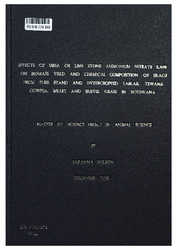| dc.description.abstract | This study investigated if Urea or LAN had any effect on biomass yield and chemical composition (Macro and micro mineral) of silage made from fodder crops of Lablab (Lablab purpureas), Tswana cowpea (Vigna unguiailata), millet (Panictim miliaceum) and Buffel grass (Cenchrus ciliaris). The crops were cultivated as monocrops (pure stand) as well as intercropped. The intercropping was done between legumes and cereals as follows: Tswana cowpea with millet, Tswana cowpea with Buffel grass, Lablab x millet and Lablab with Buffel grass. The experimental design adopted for this study was Completely Randomised Design (CRD). The crops were planted at Botswana University of Agriculture and Natural Resources (BUAN), Notwane farm in October 2009. Harvesting of the crops was in January 2010 and the silages were made immediately after harvesting of the forages. Ail chemical and mineral analysis was done at the Botswana University of Agriculture and Natural Resources (BUAN)’s Animal Nutrition laboratory. The first study dealt with biomass yield of pure stand as well as intercropped forages fertilized with urea or LAN or without fertilizer application. The results from the study showed that dry matter (DM %) content, fresh yield und biomass yield of both pure stand and intercropped forages were significantly different with crop variety (P < 0.05). The pure stand legume forages had low dry matter content whereas pure stand cereal forages had high dry matter content in contrast, pure stand cereal crops had low fresh yield and biomass yield than pure stand legumes crop forages. Pure stand Lablab forages had the highest fresh yield as well as biomass yield of 52,648.5 kg/ha and 9,975.17 kg/ha respectively than the rest of the pure stand crop forages. In intercropped forages, Lablab with Buffel or millet had higher fresh yield as well as biomass yield than Tswana cowpea intercropped with the same. Lablab with Buffet grass produced the highest fresh yield as well as dry matter yield (biomass) of 45,548 kg/ha and 9,103.87 kg/ha respectively. The result further indicated that Tswana cowpea with Buffel grass yielded the least dry matter (DM %) content of 19.28 DM %. The second study focused on chemical composition (Ash, NDF, ADF, ADL and CP), macro and micro mineral compositions of silages made from pure stand and intercropped forages fertilized with either urea or LAN or without fertilization. The result of the study indicated that the chemical composition of pure stand crops silages were significantly different with (P < 0.05) crop varieties except for ADL content (P > 0.05). The results further indicated that pure stand legume crops had higher ash and crude protein content as well as low NDF and ADF than cereal forages of the same. Under macro clement composition, magnesium composition of pure stand crop forages was highly significant (P < 0.05)). However, phosphorous (P) and Sodium (Na) concentration tended to be affected by crop type (P > 0.05). In general, the micro clement concentration such as Cu, Zn, Mn and Fe of silages made from pure stand crops were found to be insignificant (P > 0.05. However, pure stand Tswana cowpea silage exhibited higher and insignificant iron (Fe) concentration of 103.85 mg/kg DM than rest of the pure stand crops silages. The results further indicated that the chemical compositions of intercropped silages were not significantly (P > 0.05) different between crop varieties. Nevertheless, the ash and crude protein (CP) content tended to be significant (P > 0.05). Still ash and crude protein content were higher in intercropped silages than pure stand crop silages. In macro element composition, the calcium (Ca) concentration of intercropped silages was highly significant (P < 0.05) whereas magnesium concentration tended to be significant (P > 0.05). Similarly, concentration of sodium and phosphorous were not significant (P > 0.05). In General, micro element concentrations of intercropped silages were not significantly different between, crop… | en_US |

